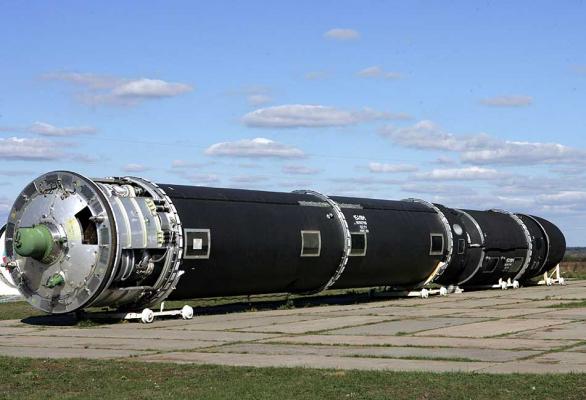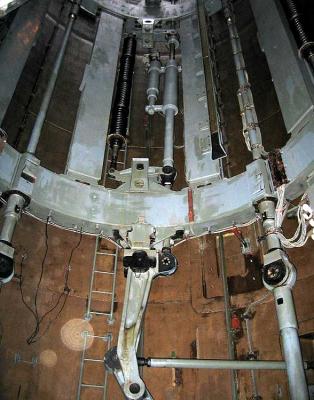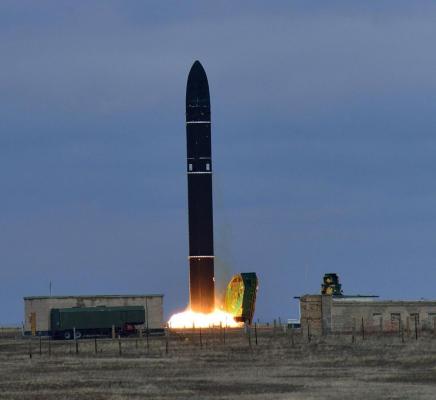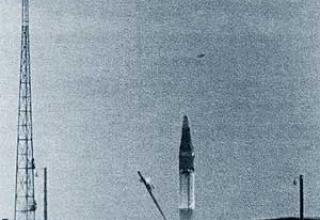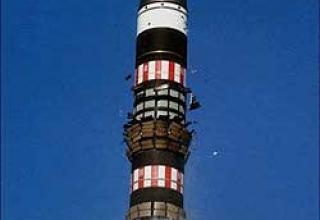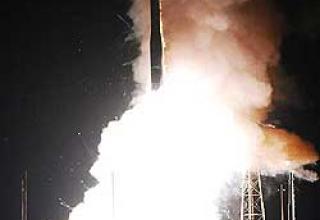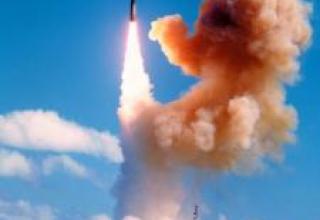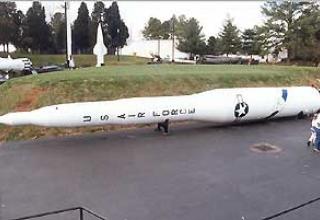The fourth generation R-36M2 Voevoda (15P018M) missile system with a multipurpose 15A18M heavy class intercontinental missile was developed by Yuzhnoye Design Bureau (Dnepropetrovsk) under the leadership of Academician V. F. Utkin in accordance with the tactical and technical requirements of the USSR Ministry of Defence and the Decree of the CPSU Central Committee and the USSR Council of Ministers of 09.08.83. Voevoda" complex was created as a result of the project of improvement of the complex of strategic purpose of heavy class R-36M (15P018) and is designed to engage all types of targets protected by modern anti-missile defense equipment in any conditions of combat use, including multiple nuclear effects on the position area (guaranteed retaliatory strike).
Flight development tests of the R-36M2 complex started at Baikonur in 1986. The first missile regiment with R-36M2 ICBMs went on combat duty on July 30, 1988 (Dombarovsky, commander O.I.Karpov). By decree of the CPSU Central Committee and the Council of Ministers of the USSR of 11.08.1988, the missile system was adopted into service.
Tests of the complex with all types of combat equipment were completed in September 1989.
Rockets of this type are the most powerful of all intercontinental missiles. In terms of technological level, the complex has no analogues among foreign Kazakhstan. The high level of tactical and technical characteristics makes it a reliable basis for SNF in solving tasks of maintaining military and strategic parity. Until recently, Kazakhstan was a base for the creation of asymmetric countermeasures against a multi-missile defense system with space-based elements.
Under the leadership of N.I.Gushchin, Chief Designer of the Machine-Building Design Bureau (Kolomna), a complex (complex 171) of active defense of the Strategic Missile Defense Systems of the Strategic Missile Forces against nuclear warheads and high-altitude non-nuclear weapons was created, and for the first time in the country low-altitude non-nuclear interception of high-speed ballistic targets was carried out.
In 1998, 58 R-36M2 missiles were deployed (NATO designation SS-18 "Satan" mod.5&6,РС-20В).
Composition:
In order to ensure a qualitatively new level of TTH and high combat efficiency in particularly difficult conditions of combat application, the development of RK "Voevoda" was conducted in the following directions:
- to further improve the survivability of the PU and KP;
- ensuring stability of combat control in all conditions of application of RK;
- expanding operational capabilities for re-targeting missiles, including firing at unscheduled targets;
- ensuring the flight resistance of the missile to ground and high-altitude nuclear explosions (LEO);
- increasing the autonomy of the complex;
- increase in the guaranteed service life.
One of the main advantages of the established RK is the ability to ensure the launch of missiles in the conditions of a retaliatory strike under the impact of ground and high-altitude nuclear weapons. This has been achieved by increasing the survivability of the missile in the SHU and a significant increase in the missile's resistance in flight to adverse effects of nuclear weapons (wafer-welded missile body made of AMG-6 NPP with multifunctional coating, Schematic-algorithmic protection of the control system equipment from gamma radiation at the nuclear power plant has been introduced, and the speed of the control system stabilization automat executive bodies has been doubled, the head fairing separation after passing the zone of high-altitude blocking nuclear power plants, thrusting of the rocket stages I and II by the thrust of the engines, increase of the systems and elements resistance has been increased (see Table 2). (see photo1, photo2, photo3, photo4).
As a result, the missile's AB blocking zone radius, compared to 15A18, has been reduced by a factor of 20, X-ray immunity increased by a factor of 10, and gamma-neutron immunity increased by a factor of 100. The missile's resistance to dust formations and large ground particles present in the cloud at ground-based X-ray radiation is ensured.
The effectiveness, flexibility and efficiency of the combat application of the complex has been significantly increased:
- to increase accuracy by 1.3 times;
- the use of higher power charges;
- 2.3-fold increase in the area of the combat unit deployment zone;
- possibility of launching from the mode of permanent combat readiness on one of the planned target designations, as well as operational reorientation and launching on any unscheduled target designation transferred from the highest control level;
- a 3-fold increase in the autonomy duration;
- halving the combat readiness time.
As a result of implementation of progressive technical solutions, the energy capabilities of the missile have been increased by 12% compared to 15A18 missile, while meeting the conditions of restrictions on the dimensions and starting weight imposed by the OSV-2 Treaty.
The development of the RC (see diagram) was based on the infrastructure of the previous complex 15P018. The existing engineering structures, communications and systems were used to the maximum extent possible. The highly effective multipurpose rocket on liquid high boiling components of fuel, completely ampulsified, is intended for hitting especially important objects located in a range from average to intercontinental.
The missile (see photo) is designed in the size and launch weight of 15A18 missile on a two-stage scheme with a sequential arrangement of steps and a system of breeding of elements of combat equipment. The missile has preserved the schemes of launch, stage separation, separation of steps, separation of elements of combat equipment, which showed a high level of technical perfection and reliability in the 15A18 missile.
The levels of the missile's resistance to PFN, which were implemented to ensure a countermeasure launch, ensure its successful launch after nonpowering nuclear material directly on the booster and without reducing its combat readiness when exposed to the adjacent booster. At the same time, the energy capabilities of the missile have been increased:
- improvement of engine performance, implementation of the optimal remote control shutdown scheme;
- implementation of the II stage engine installation in a "recessed" version in the fuel cavity;
- improvement of aerodynamic characteristics.
The dilution motor unit is a four-chamber LCD with swivelling combustion chambers, which are extended to the operating position during flight. The universal liquid propellant dilution system is operated as a part of the rocket (as opposed to 15A18 rocket), which allowed to carry out a complete assembly of the rocket in the conditions of the manufacturer, to simplify the technology of work at combat facilities, to increase reliability and safety of operation.
A new one-piece ogival-shaped head fairing has been developed for the missile, which provides reliable protection of the HC from PFLAs, including large soil particles, and improves aerodynamic characteristics.
The TTT provided for combat equipment of the missile with four types of head units:
- two monoblock HFs with "heavy" and "light" BBs;
- HGH with ten uncontrollable BBs;
- Mixed MF, consisting of six unmanned and four controlled UAs with a homing system on maps.
The 15F178 controlled combat unit was developed for mixed RPG. It was designed as a bioconical body of minimal aerodynamic resistance. A deflected conical stabilizer for pitching and yaw and aerodynamic rollers were accepted as executive bodies of BMP flight control in the atmospheric section. During the flight the stable position of the block pressure center was ensured when the angle of attack was changed. The orientation and stabilization of the BMP out of the atmosphere was provided by a reactive thrust unit operating on liquefied carbon dioxide.
As part of the combat equipment there were created high-performance JV anti-missile defense (TLC, LLC, DO), which are placed in special cassettes, thermally insulating booster covers were used.
The control system is based on two high-performance Pulp and Paper Mill (onboard and ground) of the new generation and a high-precision BCP continuously operating in the process of the DB with the use of an element base of increased resistance to fossil fuels. A number of fundamentally new ideas have been implemented in the SU:
- to ensure operability after a nuclear explosion in flight;
- precision individual breeding of combat units;
- a "direct" guidance method that does not require a previously prepared flight task;
- providing remote targeting, etc.
The solution of these problems was provided by a new powerful onboard computer complex using semiconductor "burnable" permanent and electronic operational memory devices. The main element base was developed and manufactured in Minsk Production Association "Integral" and provided the necessary level of radiation resistance. In addition to standard units, the on-board complex included, first implemented in the USSR, a specialized memory unit on ferrite cores with an internal diameter of 0.4 mm, through which 3 wires were stitched thinner than human hair. For one of the types of combat units was developed and for the first time in the Soviet Union was flight tested storage device on cylindrical magnetic domains.
The required temperature regime for continuously operating devices is provided by the newly created STR (heat release to the PU volume).
The combat application was provided in any weather conditions at the air temperature from -50 to +50°C and wind speed at the ground surface up to 25 m/s, before and under the conditions of nuclear impact on the DBK.
Characteristics:
| General characteristics | |
| Maximum range of fire, km: - with Heavy Class-RGH. - monoblock HF |
11000 16000 |
| Firing accuracy, km | ±0.5 |
| Generalized reliability indicator | 0.935 |
| Rocket's PFC resistance in flight | Level 2 (response launch provided) |
| Launch time from full alert, s. | 62 |
| Warranty period of being on combat duty (according to the unregulated scheme for PU), years | 15 |
| 15A18M rocket | |
| Diameter, m | 3 |
| Length, m | 34.3 |
| Launch weight of the rocket, shh: - with hCG - with a light class HF |
211.4 211.1 |
| Weight of the head end, shh: - with 10-block RSH - with a lightweight BB |
8.73 8.47 |
| Fuel: - oxidizer - fuel |
AT NDMG |
| Weight of fuel, shh: - Stairs I - II stages - stages of breeding |
150.2 37.6 2.1 |
| Flight Reliability | 0.974 |
| Energy Performance Coefficient Spg/Go, kgf/t | 42.1 |
| Remote Control Features | |
| Traction remote control (on the ground / in the void), ps: - Stairs I - II stages - stages of breeding |
468.6/504.9 - / 85.3 - / 1.9 |
| Remote control specific impulse (on/in the ground/in the void), c: - Stage I - II stages - stages of breeding |
295.8/318.7 - / 326.5 - / 293.1 |
Testing:
High combat and performance characteristics of the missile system are confirmed by ground (including physical experience) and flight tests. Under the programme of joint flight tests, 26 launches were conducted at 5 NIIP, of which 20 were successful. The reasons for unsuccessful launches were determined. Schematic and design improvements were carried out which made it possible to eliminate the shortcomings identified and to complete the flight tests with 11 successful launches. In total, 33 launches were conducted, the actual flight reliability of the rocket by the total number of conducted launches is 0.974.
In the course of the SLI it was decided to exclude from the mandatory combat equipment the "heavy" booster and RGH of mixed configuration. CR with "heavy" booster was being prepared for production, but was not subjected to flight tests. Mixed version RSH was tested as part of the 15A18M missile by launching in the "Kura" area (3 launches). Two 15A18M missiles, two 8K65MR carriers and a full set of combat units were prepared to continue flight tests. However, after 1991, the work on the BMP was closed. The same fate befell the DEC work on penetrating combat units.
The experimental penetration unit was created on the basis of the aerodynamic design of the conventional BB 15F158U with the participation of VNIIEF (S.N. Lazarev, A.I. Rudakov, V.I. Uvarov). A nose penetrator made of titanium alloy was installed in the unit. Manufacturing of the penetrator was mastered at the Pavlograd Mechanical Plant. The models were tested by firing from artillery guns into the ground. Natural samples were tested at the Aralsk firing range on 8K63 rocket and at the Kura area on 15A18 rocket. In the period 1989-1990 five blocks were tested with successful results. However, the work on the regular infiltration units, started on the basis of the accumulated experience, was closed down after 1991.
Sources:
- "Призваны временем. Ракеты и космические аппараты конструкторского бюро "Южное"./ Под общей редакцией С.Н.Конюхова/. Д.: Арт-Пресс, 2004,-232с.
- Карпенко А.В., Уткин А.Ф., Попов А.Д. "Отечественные стратегические ракетные комплексы". СПб, Невский бастион-Гангут 1999 год.
- Межконтинентальная баллистическая ракета Р-36М (15А14) / Р-36МУ (15А18) / Р-36М2 (15А18У)
- С. Деревяшкин,А.Богатырев, "Сатана" - дочь "Воеводы" «Красная звезда». 21.04.2001
- Ракета носитель "Днепр" ICS "Космотранс"
- "Cатана" превращается в "Днепр" Space News.ru
- Р-36М

